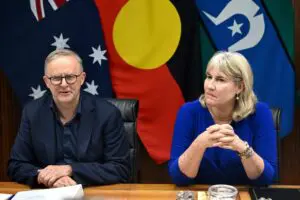Could the biggest carbon polluter in history, the United States of America (US), become the world’s most ambitious climate actor under its new President, Joe Biden?
Just last month Biden’s top official for climate action, John Kerry, was so brazen as to lecture the United Nations Security Council that failing to work together to address the threats of climate change is “almost tantamount to a mutual suicide pact”.
The US only officially re-joined the Paris Agreement two weeks ago, and it is trying to make up for lost time. In his first month in office, President Biden has done more for the climate than the Australian Coalition Government has done in 8 years.
The seismic shift in US climate politics has left a growing rift between Australian and US climate policy.
In 2019 the international Climate Change Performance Index rated Morrison’s climate policies dead last in their assessment of the 57 largest polluting countries (an assessment Morrison was quick to reject).
In 2020, Australia came in second last only to Trump’s America, and this year, well you don’t have to look too hard to see how Biden is turning the tables.
Take electric vehicles – in his first week as President, Biden committed billions to replacing the entire US government fleet with electric vehicles. The Australian Government won’t be following suit with its fleet, despite costing a of maximum $200 million according to the Parliamentary Budget Office or more likely a fraction of that, around $20 million according to experts quoted by TheDriven.io.
Recall the federal government has announced around $200 million to help frack the Beetaloo Gas Basin. And you can expect more taxpayer support for gas in the next federal budget.
Speaking of gas, Biden has immediately hit pause on new oil and gas leases in public lands (including the controversial Keystone XL pipeline project). Morrison, by contrast, wants to dig up more fossil fuels as part of a gas-fired economic recovery (though not personally, he doesn’t hold a shovel).
This is despite the gas sector providing hardly any jobs and paying hardly any taxes – even Pauline Hanson is complaining that our gas is being ‘given away for free’.
There have been some promising signs from Morrison since Biden was elected, including moving away from using the controversial and legally baseless Kyoto Credits and towards a net-zero by 2050 target. But a promise not to cheat with dodgy credits and a ‘preference’ for net-zero by 2050 are small beer.
Last month, John Kerry pointed out Australia’s problematic role at the most recent UN climate conference in Madrid in 2019. More will be expected of Australia, especially on the international front.
Take the United Nation’s Green Climate Fund (GCF) which helps developing countries implement the Paris Agreement. After Trump pulled the US out, Morrison followed, pulling us out of the fund during a live talk-back radio interview.
Up until our undignified exit (that surprised even our own government officials), Australia had played a leading role in the development and management of the fund. With Biden back in the GCF, Australia is the only developed nation sitting on the sidelines.
Hopefully, Biden’s upcoming climate conference on 22 April 2021 is an opportunity to mend the fault lines separating US and Australian climate policy.
The (likely) virtual summit will revive an Obama-era meeting of the 17 largest economies and emitters. Unlike the UK’s Climate Action Summit last December that allocated speaking slots based on ambition (and therefore left out Australia), the Biden Summit will certainly invite Morrison because Australia is a major carbon polluter (and an even bigger carbon exporter).
Biden is hoping that the ‘power of example’ will convince laggards like Australia to shift course. The US currently has an emissions reduction target for 2025, of 26-28% from a 2005 baseline.
If that sounds familiar, it’s because it is the same as the Australian government’s target, except Australia has until 2030 – five extra years to achieve the same reduction. It’s like Australia is sitting the same exam and aiming for the same grade, but has five additional hours to answer the questions – not so impressive.
Especially following the recent target analysis from the UNFCCC which found national governments, including Australia, have fallen ‘far short’ or required reductions.
The US will use the Summit to announce a ramped up emissions target for 2030 – in the realm of a 38-54% reduction from 2005 levels, according to Climate Analytics – and build momentum to reengage other major emitters including China.
Like the US with John Kerry, China has recently appointed the same official who helped broker the Paris Agreement to lead its international climate work.
Right now, China has a more ambitious long-term climate plan than Australia (to be carbon neutral by 2060), which it will tease out in its next five-year plan this month. There is also strong appetite from the US to work with China on climate, not just from the Biden administration, but from the majority of Americans.
Optimism is certainly warranted on the climate front. Biden’s commitments signal that the tides of climate diplomacy are changing.
In light of the continuous waves of the COVID-19 pandemic, the UN climate negotiations could even take the unprecedented step of going online. And if the slow, grinding pace of the UN is willing to move with the times, maybe it is time that Morrison does too.
Richie Merzian is director of the Climate & Energy Program at independent think tank The Australia Institute @RichieMerzian









